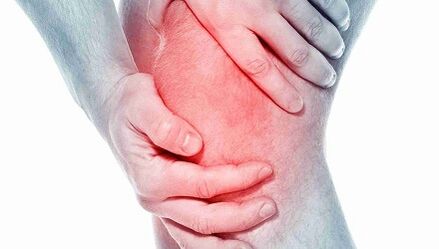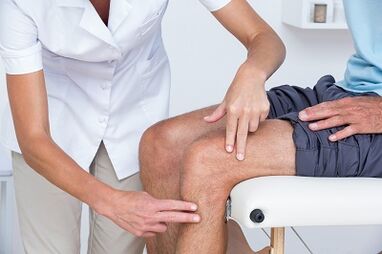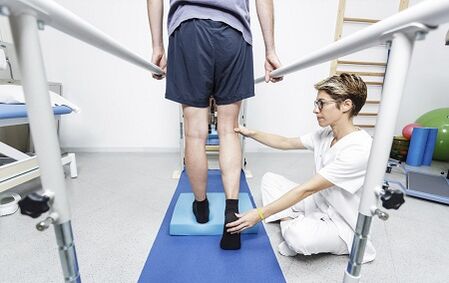The artery of the knee joint is a chronic (long-lived) degenerative disease that causes the destruction of cartilage in joints.Symptoms include pain, stiffness and swelling.To reduce pain and disability, treatment options include changes in lifestyle (in diet, physical exercise), treatment, medications and physical methods of operation.
Osteoarthrosis of knee joint
Osteoarthrosis of the knee joint is a common disease accompanied by chronic, tedious pain.Recent clinical data showed that central sensitivity stimulates the deformed osteoarthrosis that deform the knee joint.Increasing the arthrosis of the artery of the arthrobis of knee compounds affects the processing of pain, it is very important for determining new analgesic targets / new therapeutic strategies.
Inhibition receptors weaken the function of peripheral immune cells and change the center neuro-immune response.The receptor agonist's systemic application of the OA is a change in the induction of the induced painfulness and change of cytocks against circulation and inflammatory cytocks.
Deforming arthrosis
Deformation of knee joint is the wearing of inflammation and cartilage in bones that form the knee joint (osteo = bone, arthrobe = combination, bone, an inflammation).The diagnosis of the osteoarthritis of the knee joint is based on two main results: radiographic information on changes in bone health (using MRI X-ray and magnetic resonance description) and human symptoms).About 14 million people have symptomatic knee arthropies.Although the older people were spreading more, 2 million of 14 million people with a symptomatic OA were younger than 45 years old and were more than half and older than half.
Osteoarthritis (OA series) is a progressive disease caused by the inflammation and degeneration of the knee joint in time.
It affects all joints, including bones, cartilage, ligaments and muscles.Its development is affected by age, body mass index (BMI), bone structure, genetics, muscle strength and level of activity.OA can also develop as a second state after the knee injury.The presence of the disease and the presence of injuries or conditions or conditions related to it, OA can be controlled using physical therapy.More violent or expandable cases may require surgical intervention.
Symptoms
Persons developing knee oa can live extensive symptoms and restrictions based on the development of the disease.The pain occurs when the cartilage covering the bones of the knee joint.The areas where the cartilage is worn or damaged and exposes the bone beneath the bone.The impact of the bone allows you to squeeze the stress and cartilage and sometimes increase the bone contact, which can cause pain.Since the knee is a partner, the level, level of activity, as well as the type and duration of the actions, as a rule, directly affects symptoms.Symptoms may worsen with weight activity while walking with a heavy object.

There may be symptoms of knee joint:
- Deterioration of pain during or after surgery, especially during a walk, while climbing, while the stairs or sitting is in a permanent situation.
- Pain or stiffness after sitting in a long period of time bent or sitting with a flat knee.The pain is the most common sign of osteoarthritis.The pain can be permanent, as the disease is developing and inflammation.
- Skip, cracks or grinding feeling while moving knees.
- Swelling after the action.
- The hardness of the affected combination was often seen for the first time after morning and rest.
- Sometimes the paid on the touch of the touch is noticeable in joining with arthritis.
- Deformation can occur with osteoarthritis due to bone growth and loss of cartilage.The growth of the bones in the final combinations of the fingers is called Hyberen's nodes.Bushar nodes are the growth of bones in middle joints of fingers.The cartilage of the cartilage of the knee joint can lead to the external curvature of the knees (onion-foot).
- When arthritis moves, a Kriking sound or a grat sensation may appear.This is caused by wiping bone from bone or rough cartilage.
These symptoms usually do not go through time and suddenly, but also gradually develop in time.Sometimes people do not accept osteoarthritis because they cannot recall a certain period or injury causing their symptoms.Knee pain is better to ask for a few months, it is worse for a few months that do not respond to rest or activity.
Diagnosis
Osteoarthritis is often diagnosed with pain, reduced movement and / or characteristic signs of deformation.Osteoarthritis can be confirmed by X-ray or MRI scan.The general information includes the narrowing of the articular space between the bones, the loss of cartilage and bone waves or bones growth.Blood tests can be used to exclude other possible conditions, but cannot diagnose osteoarthritis.

2 main process in Kiza OA is diagnosed.First, based on a report on symptoms and clinical examination.Physiotherapist will ask questions about medical history and activity.The therapist will conduct a physical examination to measure the action for the directory (range of action), power, mobility and comfort.You may ask for different movements to see or increase pain.
The second vehicle used to diagnose knee joint is a diagnostic visual image.Physiotherapist can send the doctor to determine the X-month in different positions to check the damage to the knee and spark damage.
If combinations are more serious damage, you can order a MRI to learn more carefully in the general state of articular and surrounding parts.
Blood tests can also be ordered to rule out other conditions that can cause symptoms similar to the osteoarthritis of knee joints.
Treatment
The severity of the arthritis depends on the severity of the arthritis and the age of the patient, how to treat the arthrosis of the knee joints.Treatment may consist of operations or conservative methods or their combinations.
The first treatment line of the redemption of the knee joint includes the modification of activities, anti-inflammatory medications and weight loss loss.
The rejection of the actions that increase pain can make this situation acceptable for some people.Anti-ratified medications help lighten the inflammation that can help pain.
Physical therapy to strengthen the muscles around the knee can help you swallow a part of the shock.It is true for arthritis, especially the knee cup (Patello-femoral).Special braces can easily relieve pain to transfer the load to part of the knee joint with less than arthritis.The injections of drugs inside the knee joint can also help temporarily.
In addition, walking with a cane in the hand of the opposite side can help you distribute the part of a painful knee, reduces the pain.Finally, the loss of weight loss helps to reduce the power passing through the knee joint.The combination of these conservative measures can help eliminate pain and prevent disability.
If these methods do not allow you to allow the situation tolerance, the operation can be the best choice for the treatment of the arthritis of knee joint.The exact type of transaction depends on age, anatomy and the main situation.Some examples of surgical options for arthritis treatment include osteotomy, which consists of cutting the bone to align the combination.
Modern methods of treatment of knee joint arthritis include osteotomy, which is a good alternative to the patient's young and arthritis, this and the arthritis is limited to an area of the knee joint.This allows you to reconstruct the knee to attract the Nija to loosen the arthritis area and covering part of the directory.For example, the patient can be reset to redistribute the load through the joint.The advantage of this type of operation is the protection of the patient's own knee joint and the patient can ensure the comfort of the pain for many years without a deficiency of the prosthesis.Disadvantages include a longer rehabilitation course and the ability to develop arthritis in the recently adjusted knee.
The operation to replace the knee joint includes the cutting of the arthritis bone and putting a prosthetic combination.All arthritis are changed, including surfaces, femur, bottom leg and knee cup.Arthritis surfaces are removed and the ends of the bone are replaced by prosthesis.The prosthetic component is generally made of metal and plastic surfaces designed for smooth sliding against each other.
To replace knee joint
The total operation was first implemented in 1968 to replace the knee joint and developed in a reliable and effective way of pain when the years have passed the active life of patients.Surgical methods and implants helped make one of the most successful orthopedic procedures today.As the population ages and continues to increase the need to change the direct knee, as the population goes more active.Many operations took place in a special operating hospital to replace the knee joint.Improving surgical technology and the design of new implants is some contributions to surgeons.
When people often have to replace their knees.This is an individual question that depends on the level of human activity and the level of functional needs.Many people with arthrosis live with pain that prevents them from participating in activities;The others are so weak that they are hard to wear shoes and socks.The full replacement of the knee joint offers a solution to the arthrosis problem and is carried out to eliminate and continue the pain.Patient can make a pain-free operation after recovery after the successful change of knee combination.The full replacement of the knee combination significantly improves the patient's condition and significantly reduces treatment costs for a long time.This study showed that not only the general change of knee partnerships is economically effective, but also greater functionality and quality of life.
The full replacement of the knee joint is considered a large operation and the solution is not meaningless.Usually people decide to hold an operation when they can no longer live with Arthritis.
The implant consists of 4 parts: Tibia, Femur parts, plastic supplement and a pattern.Components of Tibia and Femur are made of metal, usually used to close the ends of the bud and the lower leg after removing the arthritis bone.Plastic is made from the ultra -igh surface polyethylene and the polished thigh surface is component to the Tibia component for slides along the plastic.The component of the knee cup also shifts in front of the femur component.They are usually connected to bone cement.
Full change of the knee is carried out in the operating room with a special laminar air flow system that helps reduce the likelihood of infection.Your surgeon will wear "space" designed to reduce the likelihood of infection.The entire surgical group will consist of your surgeon by two to three assistants and nonsense.
Anesthesia is given through an epidural catheter with a small pipe that includes the back.During the operation, the patient can be both awake and sleepy.
The epidural block application around your thigh will be placed in a tourniquet or a cuff.During the operation, it will erode a horizontal bar to reduce bloodshed.Cutting to change the knee is made along the front knee.The cut is measured between 4 and 10 inches depending on anatomy.
Femurun, lower legs and patella arthritic surfaces are exposed and removed using power tools.At the same time, the deformations of the knee are corrected and the knees are more straightforward after surgery.The bone is ready to take an artificial knee joint and then the prosthesis is included.Two drains are installed around the work area to help in the blood cavity during closing.Documents are used to close men.

The whole operation will be between 1 and 2 hours.After that, patient tests will be checked for the restoration room.Most patients can be taken to a regular room within a few hours;The others will be able to stay in the hall for recovery, as a surgeon and anesthesiologist.
Patients usually remain in the hospital for 3-4 days after a full operation to replace the knee
Risks during operation
Some of the risks of the surgical procedure are likely to occur, the formation of bloodshed, the form of a lax.The total spread of these risks is very small.Before the operation begins, they must be discussed with surgeons.
Some risks of a prosthetic identity include the possibility of some risks, which may weaken or get the prosthesis from time to time or be infected.However, these issues will be discussed with surgery.
The postoperative course
The patient will fall into the restoration room immediately after a complete operation to replace the knee combination.Most patients can enter a regular ward in a few hours in the sensation legs.An epidural catheter associated with an epidural catheter will be given an epidural catheter that allows you to control when a treat for pain.
As shown by the operation day, a physiotherapist, you can do some exercises, including reducing quadriceps and moving the legs up and down.Depending on the surgeon's choice, you can start twisting your new knee immediately after the operation or the first day.You will be allowed to pick up ice after surgery to soak the patient's mouth, but can cause liquids or nausea.The patient will be a catheter in the bladder so you don't have to worry about urine.Once the movement in the legs will be allowed to sit, climb and take a few steps with walking and therapist.
The first day after the operation is to be active, it is designed to help you become more mobile.
The patient will meet with physiotherapists who instructed additional training.In addition, they will help you reach your feet and take a few steps with a walk.As a rule, the patient will be allowed to drink clean liquid.
It will be easier and easier to move in the following days.The patient will be released from pain and urinary catheter.The treatment of pain will be given in the form of tablets.The second postoperative day, if there are signs of recovery in the intestines, ordinary food will be allowed.
Depending on your age, it can be a candidate for a short living in a patient rehabilitation organization in a patient rehabilitation organization for physical condition and insurance cover.Otherwise, the patient will be removed from the house and the physiotherapist will come to his house to continue rehabilitation.Dispatcher will discuss these options with the patient and help you plan to return to it.
Returning to the event will lead a surgeon and therapists.As a rule, patients can walk as much as 6 weeks after the operation.Patients can move on in 6 weeks.After 8 weeks, the patients can continue the game in golf and swimming;They can play tennis in 12 weeks.The surgeon will help you decide which actions will begin again.
What physiotherapist needs physiotherapist

All physical therapists are prepared through an educational and clinical experience for the treatment of various conditions or injuries:
- After the operation to replace a physiotherapist and knee joint with experience to treat people with an osteoarthritis of knee joint.Some physiotherapists have an experience with an orthopedic focus.
- A certified orthopedic clinical specialist a physiotherapist.This physiotherapist will have advanced knowledge, experience and skills that can be applied to a state.
- You can find physiotherapists with this and other accounting information using a MRI to help you find physiotherapists with special clinical knowledge.
General tips when you can find physiotherapist (or other supplier of medical services):
- Recommend recommendations from other suppliers of family and friends or medical services;
- In order to adopt a clinic for physiotherapy, you need to ask about the experience of physiotherapists to help people with arthritis.
During the first visit to physiotherapist, you should be ready to describe the symptoms as more detailed and condemning the situation.



















